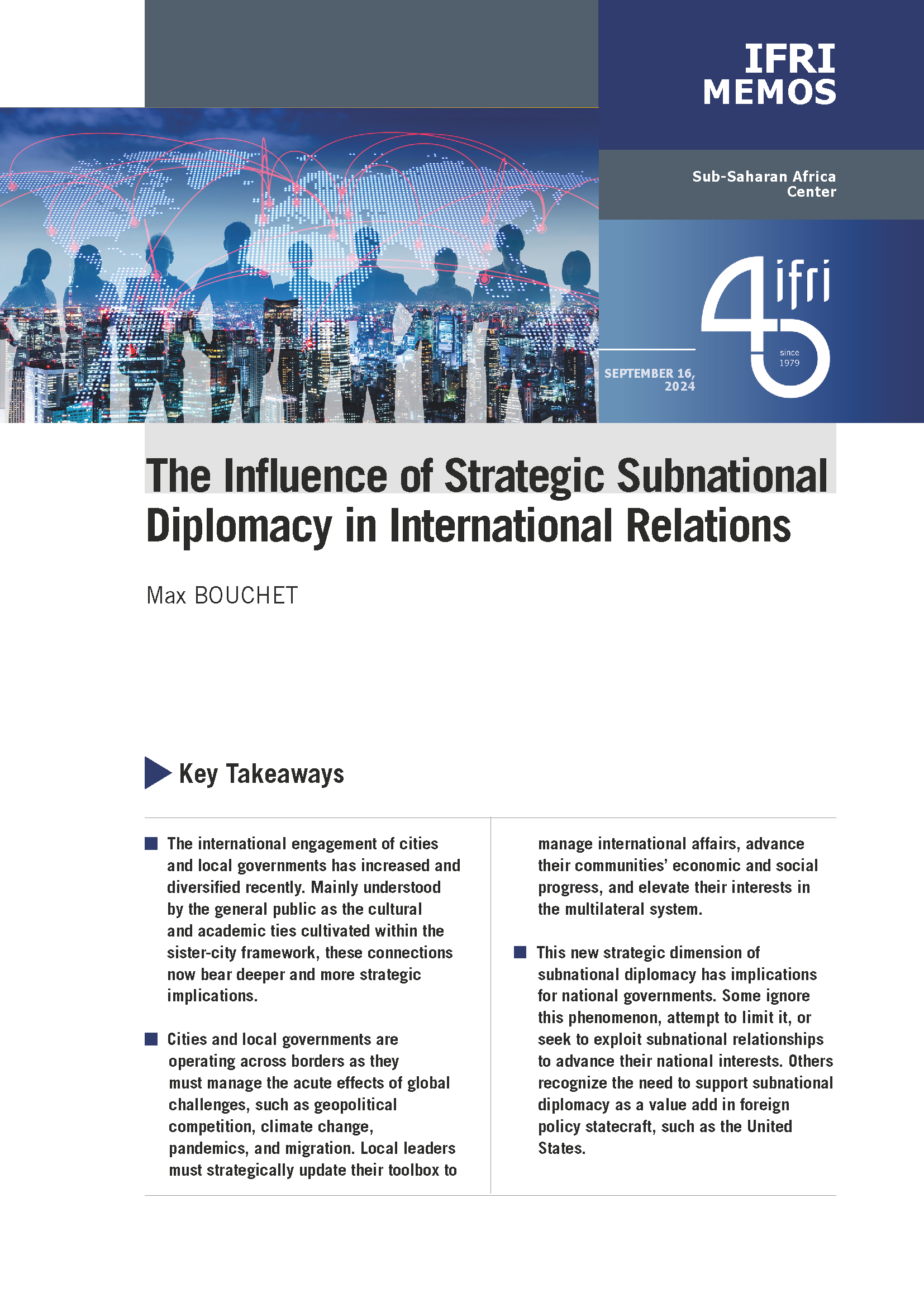Sixty Years after Brown: Resegregation in America

This piece is the second in a series of four Chroniques américaines on education in the United States, published this week.
May 17th, 2014 marked the sixtieth anniversary of the landmark U.S. Supreme Court case Brown v. Board of Education (1954), whereby a unanimous vote of 9-0, the Court under Chief Justice Earl Warren ruled that segregation enforced by law is a violation of the Fourteenth Amendment. Brown overturned previous Court rulings, including Plessy v. Ferguson (1896), by ruling that “separate but equal” public education facilities are unconstitutional, thus forging the pathway for the desegregation of public schools. However, the Court merely dictated that the integration was to begin with “all deliberate speed”: it was not until the Civil Rights Act of 1964 that significant change occurred across the nation, as the Act barred school districts from receiving federal education funding if they discriminated against black students. [1] In just four years, from 1964 to 1968, the percentage of black students attending majority white schools in the South skyrocketed from 2.3 to 23.4 percent, a rate that continued to increase until 1988. That year, 43.5 percent of African-American students in the South attended majority white schools. [2]
The benefits of desegregated schools have been clear: a 2014 study by Rucker Johnson at the University of California, Berkeley, found that desegregation’s impact on racial equality is significant and long-lasting. [3] In Johnson’s study of Americans born between 1945 and 1968, black Americans who attended integrated schools were more likely to graduate, go on to college, and earn a degree than those in non-integrated schools. They also made more money, were significantly less likely to spend time in jail, and were healthier. Johnson discovered, too, that five years of integrated schooling increased the earnings of black adults by fifteen percent. These benefits were not at the expense of white students, as those white students in integrated schools did the same academically as those in non-integrated schools. [4]
However, since 1988, rates of integration have decreased significantly. Schools districts, students, and families have been facing for over two decades a frightening issue: the resegregation of American public schools. This phenomenon is not new but has recently become more prevalent in U.S. media. On April 16, 2014, the magazine The Atlantic published the article “Segregation Now …,” illustrating the consequences of resegregation in Tuscaloosa, Alabama. As a featured article, it brought resegregation news much more into the mainstream. Nikole Hannah-Jones, an investigative reporter at ProPublica, details the generations of the Dent family and how resegregation has ultimately hindered the success of granddaughter D’Leisha, struggling to gain admittance to college. Resegregation of the Tuscaloosa District occurred because of the lift of a court-ordered desegregation mandate, and in this case, some said that the appeasement of white parents trumped doing what was best educationally for their school district. It is a revelatory account for a broader American audience unearthing an issue that has been all too quietly swept under the rug. Based on this and many other devastating accounts, it is clear that Brown has not had a lasting legacy in terms of ensuring integrated public education that many thought it would bring.
The Path to Resegregation
Brown and the Civil Rights Act were both valiant strides toward integrating schools, but courts across the country faced major obstacles toward truly desegregating public education. As early as 1968, the Supreme Court began to waver in its support for desegregation. When the conservative Nixon was elected president in 1968, he appointed four Supreme Court Justices who never voted to uphold any desegregation plans. [5] The very first Supreme Court case retreating from desegregation was in 1974 with Milliken v. Bradley, whereby the Court ruled that desegregation plans to cross the boundaries of individual districts was essentially unconstitutional. This ruling was a shut-off tool available for maintaining balance in districts with large minority populations. The legal reasoning used in this decision marks a major shift in the Supreme Court from “activist” to “restraintist” approach on the issue of civil rights.
Later administrations perpetuated the rise of conservative justices in federal courts and the Supreme Court. By 1995, sixty percent of sitting federal judges had been appointed by either Reagan or George H.W. Bush. [6] In this decade, the lack of executive leadership and congressional support for desegregation has trickled down through lower courts. Moreover, the Supreme Court decisions in the 1990s established the return to local control and race-neutral school policies as the judicial priorities. Three cases in the early 1990s, the “Supreme Court Resegregation Cases,” severely restricted desegregation efforts and substantially limited district court remedies for segregation. [7] Board of Education v. Dowell, Freeman v. Pitts, and Missouri v. Jenkins made it easier for courts to lift desegregation decrees, and signaled the beginning of the end for widespread court-ordered desegregation.
Some scholars contend that this is in large part because of the conservative Supreme Court justices appointed during this era, particularly during the Nixon, Reagan, and George H.W. Bush administrations. [8] Many of the schools released from desegregation orders occurred later during the George W. Bush administration. [9] In those public schools released from court orders, over half of the integration they achieved in ten years has completely unwound. Erwin Chemerinsky, professor at the University of Southern California, claims that these “conservative justices have effectively sabotaged desegregation” and the rulings ensured “separate and unequal” schools.
In 2005, another two major Supreme Court cases heightened resegregation trends: in Parents Involved in Community Schools vs. Seattle School District No. 1 (2005) and Meredith, Custodial Parent and Next Friend of McDonald v. Jefferson County Board of Education (2005), the Supreme Court declared voluntary student assignment plans to racially integrate these schools unconstitutional by a 5-4 majority. [10] These rulings will continue to affect districts that voluntarily use race-conscious criteria to assign students to certain schools. They also demonstrate the still present divisions between liberal and conservative factions of today’s Supreme Court.
Dire Implications
Resegregation is already diminishing the prospects of thousands of students. Though many of the long-term consequences of resegregation are yet to be felt, countless students have already suffered from its effects. Sixty years after Brown, the large majority of African American and Latino students attend segregated schools. [11] Many attend so-called “apartheid schools,” where the white population is one percent or less. [12] Between 1993 and 2011, the number of black students attending schools where 90 percent or more of the students are minorities rose from 2.1 million to nearly 3 million. They are also experiencing more isolation than they did a generation ago. [13]
The consequences do not just affect individuals and their families, but U.S. society as a whole. According to Rice University sociologist and former U.S. Census Bureau director Steven Murdock, if more minority persons do not obtain the necessary education and training to reach the middle class, the U.S will become both a poorer and less competitive society. [14] As the U.S. grows more and more diverse, the consequences of neglecting to ameliorate these issues are increasing for every American, not just minorities.
The Realities Post-Brown
Currently, the U.S. does not have strong enough support from the federal government, nor the people, to limit resegregation. Though much of the rhetoric following Brown and the civil rights era seemed to show a true shift in the public’s attitudes toward race, white parents still do not want to send their children to mixed race schools. The social and political systems in the U.S. continue to “disadvantage people of color for having racial, ethnic, and cultural characteristics incompatible with whiteness.” [15] As long as race is undervalued, racial discrimination will continue to hurt minority persons’ mobility and experiences as a result. Further, the rhetoric and ideology imbued by the Civil Rights era and Brown are far behind us. The perceived need for action and activism is still low.
Because of trends in Supreme Court rulings and the conservative leaning of the Court, the U.S. has lost its only effective tool to fight the trend that keeps our students segregated, one that had supposedly worked in the 1960s and 1970s in particular. As a country, “we have lost the legal means to stop the steady decline into resegregation.” [16]
Even under the more liberal Obama administration, the executive branch has not developed incentives for schools to integrate. [17] Like George W. Bush, his administrative policies on racial isolation in schools are eerily silent. Educational priorities have shifted in recent decades from the “equality and justice” rhetoric of the Civil Rights era toward “standards and accountability” rhetoric stemming from the Reagan period. Interest in school integration has fallen through the cracks. The focus is instead on charter schools, which have been shown to divert funds from traditional schools and increase segregation. [18]
However, whether public school integration is the best way to addressing racial discrimination and social inequality in America remains an even deeper question: social programs and community-based programs could be more effective, some contend. Moreover, if America’s approach to racial issues, i.e. targeting many policies directly at racial and ethnic groups, is the most efficient way to direct public discourse remains a question, too, versus the “color-blind” French model. Though Brown’s legacy is seemingly failed, revitalizing – or reinventing – the legacy is an American dream to pursue.
[1] N. Hannah-Jones, "Segregation Now ....", The Atlantic, 16 April 2014, http://www.theatlantic.com/features/archive/2014/04/segregation-now/359813/
[2] E. Chemerinsky, “The segregation and resegregation of American public education: the courts' role”, North Carolina Law Review, n° 4, 2003, pp. 1598-1622.
[3] N. Hannah-Jones 16 April 2014, op. cit.
[4] Ibid.
[5] G. Lane and A. White, “The Roots of Resegregation: Analysis and Implications”, Race, Gender & Class, vol. 17, n° 3, 2010, pp. 81-102.
[6] G. Lane and A. White 2010, op. cit.
[7] D. Holley, “Is Brown Dying? Exploring the Resegregation Trend in our Public Schools”, New York Law School Law Review, vol. 29, n° 4, 2005, pp. 1085-1107.
[8] E. Chemerinsky 2003, op. cit.
[9] N. Hannah Jones, “School Districts Still Face Fights—and Confusion—on Integration”, The Atlantic, 2 May 2014, http://www.theatlantic.com/education/archive/2014/05/lack-of-order-the-erosion-of-a-once-great-force-for-integration/361563/
[10] A. Frey and M. Wilson, "The Resegregation of Public Schools”, Children & Schools, vol. 31, n° 2, 2009, pp. 79-86.
[11] D. Holley 2005, op. cit.
[12] N. Hannah-Jones 16 April 2014, op. cit.
[13] R. Brownstein, “"How Brown v. Board of Education Changed-and Didn't Change-American Education”, The Atlantic, 25 April 2014, http://www.theatlantic.com/education/archive/2014/04/two-milestones-in-education/361222/
[14] Ibid.
[15] S. Donahoo, “Reflections on Race: Affirmative Action Policies Influencing Higher Education in France and the United States”, Teachers College Record, vol. 110, n° 2, 2008, pp. 251-277 : 270.
[16] G. Lane and A. White 2010, op. cit., p.95.
[17] N. Hannah-Jones 16 April 2014, op. cit.
[18] G. Lane and A. White 2010, op. cit.

Also available in:
Regions and themes
Share
Related centers and programs
Discover our other research centers and programsFind out more
Discover all our analysesAUKUS Rocks the Boat in the Indo-Pacific, And It’s Not Good News
For anyone who still harbored doubts, Washington made crystal clear from the announcement of the new trilateral alliance with Australia and the UK (AUKUS) that countering China is its number one priority, and that it will do whatever it takes to succeed. Much has been said about the consequences of AUKUS on the French-US relations, but the strategic implications for the Indo-Pacific nations (including France), and for China especially, are also critical to consider.
Washington-Téhéran : l'élection de Joe Biden change-t-elle la donne ?
The recent assassination of Mohsen Fakhrizadeh, the father of Iran's nuclear program, echoes that of Qassem Soleimani in January 2020 and illustrates the policy of "maximum pressure" which has prevailed these past four years. In this context, Joe Biden's election gives rise to high expectations for the appeasement of U.S.-Iran relations.
L’inégalité du Collège électoral aux États-Unis : comment réparer la démocratie américaine ?
Since the start of the 21st century, the flaws of the Electoral College, which completes the election process of the president of the United States by indirect universal suffrage, are the target of stronger than ever criticism.
Trade Wars: A French Perspective
The Section 232 tariffs on steel and aluminum announced by the United States in March would, if applied, have little direct impact on the French economy, but rather point toward a broader trend of protectionism and economic nationalism and a widening gap in transatlantic relations that is likely to have far-reaching implications for France.










